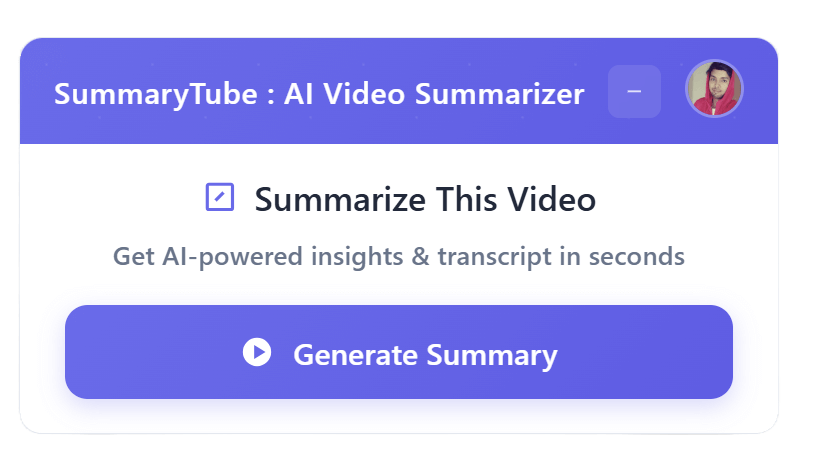GeneCIS: A Benchmark for General Conditional Image Similarity
By Sagar Vaze
Published Loading...
N/A views
N/A likes
AI Summary of "GeneCIS: A Benchmark for General Conditional Image Similarity"
Get instant insights and key takeaways from this YouTube video by Sagar Vaze.
Understanding Conditional Image Similarity
🧠 Humans understand multiple notions of similarity for images based on different conditions (e.g., same car vs. same bridge).
🚫 Existing image representations are fixed and lack adaptability to varying similarity conditions.
🌌 The key challenge is training models for an infinite set of possible conditions, necessitating zero-shot evaluation.
Genesis Benchmark Design
📊 The Genesis Benchmark is introduced for zero-shot evaluation of models that adapt to diverse similarity notions.
🎯 Models are evaluated across four conditional retrieval tasks, combining "focus vs. change" and "attributes vs. object category" axes.
🖼️ Each task involves a reference image, conditioned text, and a gallery to retrieve the correct target, designed to prevent shortcut solutions.
Scalable Data Mining for Training
⛏️ The challenge of infinite conditions is addressed by scalably mining millions of training triplets from large-scale image caption datasets.
📚 An off-the-shelf scene graph parser is used to extract subject-predicate-object relationships from image captions.
🔗 This process identifies reference-target image pairs with the same subject but different objects to generate specific conditions (e.g., "on canvas").
Model Performance & Insights
🚀 The proposed method, using automatically curated triplets, substantially outperforms all baselines on the Genesis benchmark.
🏆 It achieves zero-shot state-of-the-art performance on the MIT States benchmark and outperforms supervised baselines on CIRR.
💡 Surprisingly, performance on Genesis is only weakly correlated with the underlying CLIP backbone's ImageNet accuracy, indicating it probes an orthogonal capability in vision models.
Key Points & Insights
➡️ Prioritize adaptable image representations that can dynamically understand various similarity notions based on conditions.
➡️ Leverage large-scale unannotated data (e.g., image captions) for scalable training data generation to overcome annotation limitations.
➡️ Focus on developing models that understand general notions of similarity for open-set, zero-shot performance, rather than constrained domains.
➡️ Recognize that conditional similarity probes a unique capability in vision models, distinct from standard classification or detection tasks.
📸 Video summarized with SummaryTube.com on Aug 08, 2025, 03:35 UTC
Related Products
Find relevant products on Amazon related to this video
As an Amazon Associate, we earn from qualifying purchases
📜Transcript
Loading transcript...
📄Video Description
TranslateUpgrade
Presentation for our CVPR 2023 Highlight paper, describing the GeneCIS ('genesis') benchmark for 'Conditional Image Similarity'.
Full video URL: youtube.com/watch?v=wu3U2iNGIUw
Duration: 7:46
Recently Summarized Videos
Total Video Summary Page Visits :6
AI Summary of "GeneCIS: A Benchmark for General Conditional Image Similarity"
Get instant insights and key takeaways from this YouTube video by Sagar Vaze.
Understanding Conditional Image Similarity
🧠 Humans understand multiple notions of similarity for images based on different conditions (e.g., same car vs. same bridge).
🚫 Existing image representations are fixed and lack adaptability to varying similarity conditions.
🌌 The key challenge is training models for an infinite set of possible conditions, necessitating zero-shot evaluation.
Genesis Benchmark Design
📊 The Genesis Benchmark is introduced for zero-shot evaluation of models that adapt to diverse similarity notions.
🎯 Models are evaluated across four conditional retrieval tasks, combining "focus vs. change" and "attributes vs. object category" axes.
🖼️ Each task involves a reference image, conditioned text, and a gallery to retrieve the correct target, designed to prevent shortcut solutions.
Scalable Data Mining for Training
⛏️ The challenge of infinite conditions is addressed by scalably mining millions of training triplets from large-scale image caption datasets.
📚 An off-the-shelf scene graph parser is used to extract subject-predicate-object relationships from image captions.
🔗 This process identifies reference-target image pairs with the same subject but different objects to generate specific conditions (e.g., "on canvas").
Model Performance & Insights
🚀 The proposed method, using automatically curated triplets, substantially outperforms all baselines on the Genesis benchmark.
🏆 It achieves zero-shot state-of-the-art performance on the MIT States benchmark and outperforms supervised baselines on CIRR.
💡 Surprisingly, performance on Genesis is only weakly correlated with the underlying CLIP backbone's ImageNet accuracy, indicating it probes an orthogonal capability in vision models.
Key Points & Insights
➡️ Prioritize adaptable image representations that can dynamically understand various similarity notions based on conditions.
➡️ Leverage large-scale unannotated data (e.g., image captions) for scalable training data generation to overcome annotation limitations.
➡️ Focus on developing models that understand general notions of similarity for open-set, zero-shot performance, rather than constrained domains.
➡️ Recognize that conditional similarity probes a unique capability in vision models, distinct from standard classification or detection tasks.
📸 Video summarized with SummaryTube.com on Aug 08, 2025, 03:35 UTC
Related Products
Find relevant products on Amazon related to this video
As an Amazon Associate, we earn from qualifying purchases
Loading Similar Videos...
Recently Summarized Videos

Get the Chrome Extension
Summarize youtube video with AI directly from any YouTube video page. Save Time.
Install our free Chrome extension. Get expert level summaries with one click.